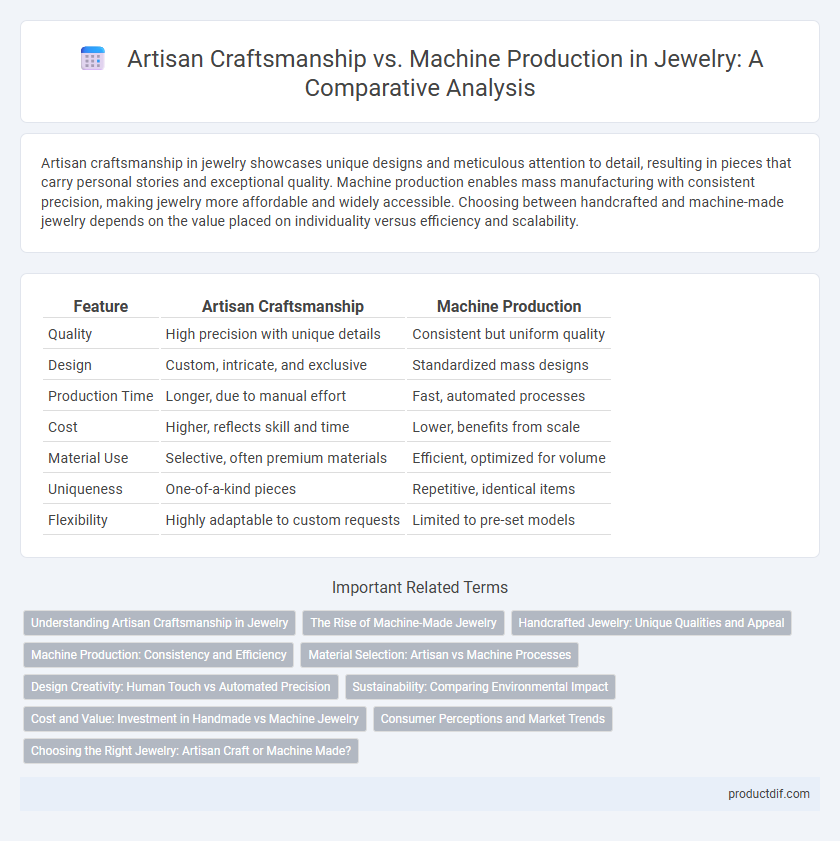Artisan craftsmanship in jewelry showcases unique designs and meticulous attention to detail, resulting in pieces that carry personal stories and exceptional quality. Machine production enables mass manufacturing with consistent precision, making jewelry more affordable and widely accessible. Choosing between handcrafted and machine-made jewelry depends on the value placed on individuality versus efficiency and scalability.
Table of Comparison
| Feature | Artisan Craftsmanship | Machine Production |
|---|---|---|
| Quality | High precision with unique details | Consistent but uniform quality |
| Design | Custom, intricate, and exclusive | Standardized mass designs |
| Production Time | Longer, due to manual effort | Fast, automated processes |
| Cost | Higher, reflects skill and time | Lower, benefits from scale |
| Material Use | Selective, often premium materials | Efficient, optimized for volume |
| Uniqueness | One-of-a-kind pieces | Repetitive, identical items |
| Flexibility | Highly adaptable to custom requests | Limited to pre-set models |
Understanding Artisan Craftsmanship in Jewelry
Artisan craftsmanship in jewelry showcases meticulous handwork, emphasizing unique designs and superior attention to fine details that machines cannot replicate. Each piece reflects the jeweler's expertise, cultural heritage, and creative expression, resulting in exclusive, high-quality products. This traditional technique often uses precious metals and gemstones, enhancing the jewelry's value and emotional significance.
The Rise of Machine-Made Jewelry
Machine-made jewelry has revolutionized the industry by enabling mass production with high precision, dramatically reducing costs and turnaround times. Advanced technologies such as 3D printing and computer-aided design (CAD) offer consistent quality and intricate detailing that were difficult to achieve through traditional artisan craftsmanship. This rise in machine-made jewelry meets growing consumer demand for affordable, trendy pieces while challenging the exclusivity of handmade designs.
Handcrafted Jewelry: Unique Qualities and Appeal
Handcrafted jewelry embodies unparalleled uniqueness due to the artisan's meticulous attention to detail and use of traditional techniques, resulting in exclusive designs that machines cannot replicate. Each piece carries a story and subtle imperfections that enhance its charm, distinguishing it from mass-produced items. The appeal lies in the authentic craftsmanship, personalized artistry, and the emotional connection forged through the creation process.
Machine Production: Consistency and Efficiency
Machine production in jewelry manufacturing ensures unmatched consistency and precision, delivering uniform pieces that meet exact specifications. Automated processes enhance efficiency by significantly reducing production time and minimizing human error. This scalability allows for mass production while maintaining high-quality standards across large jewelry collections.
Material Selection: Artisan vs Machine Processes
Artisan craftsmanship in jewelry emphasizes meticulous material selection, favoring high-quality, unique gemstones and metals often sourced through ethical means, ensuring distinctiveness and durability in each piece. Machine production relies on standardized materials optimized for mass manufacturing efficiency, prioritizing consistency and cost-effectiveness over individuality. The precision in artisan methods allows for refined textures and finishes that machines typically cannot replicate, enhancing the overall value and aesthetic of handcrafted jewelry.
Design Creativity: Human Touch vs Automated Precision
Artisan craftsmanship in jewelry design emphasizes unique creativity and intricate details shaped by skilled hands, resulting in personalized and emotionally resonant pieces. In contrast, machine production offers automated precision with consistent symmetry and flawless finishes, enabling mass production but often lacking individualized character. The human touch in handcrafted jewelry fosters innovation and subtle imperfections that enhance artistic value.
Sustainability: Comparing Environmental Impact
Artisan craftsmanship in jewelry minimizes environmental impact through sustainable sourcing, reduced energy consumption, and waste reduction, promoting eco-friendly practices compared to large-scale machine production. Machine production often relies on high energy usage and synthetic materials, contributing to carbon emissions and resource depletion. Emphasizing handcrafted pieces supports sustainable supply chains and preserves traditional techniques that align with environmental conservation goals.
Cost and Value: Investment in Handmade vs Machine Jewelry
Handmade jewelry often commands a higher initial cost due to the time-intensive artisan craftsmanship and the uniqueness of each piece, reflecting superior quality and long-term value. Machine-produced jewelry offers a more affordable price point with consistent design and mass production benefits but may lack the personalized touch and intricate details of handcrafted items. Investing in artisan jewelry supports sustainable, bespoke creations that retain or appreciate in value over time, making them prized collectibles compared to the commercial appeal of machine-made alternatives.
Consumer Perceptions and Market Trends
Artisan craftsmanship in jewelry is valued for its uniqueness, intricate detailing, and the personal story behind each piece, attracting consumers seeking exclusivity and authenticity. Machine production offers affordability and consistency, appealing to a broader market with mass-produced designs and faster availability. Market trends indicate a growing niche for handcrafted jewelry driven by sustainable practices and consumer preference for bespoke, ethically made items.
Choosing the Right Jewelry: Artisan Craft or Machine Made?
Artisan craftsmanship in jewelry offers unique designs, intricate detailing, and personalized touches that reflect skilled handwork, often resulting in one-of-a-kind pieces with higher quality materials. Machine production ensures consistency, affordability, and mass availability, making it ideal for consumers seeking budget-friendly options and standardized styles. Understanding the value of artisanal techniques versus automated manufacturing helps buyers make informed decisions based on their preferences for exclusivity, durability, and price.
Artisan Craftsmanship vs Machine Production Infographic

 productdif.com
productdif.com